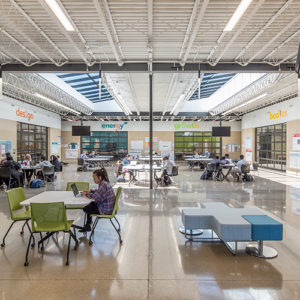Balancing Workplace Hierarchy
Say goodbye to the corner office, and hello to your team mates. Workplace design can combat rigid internal hierarchy and encourage collaboration.
Hierarchy has become a dirty word. As the baby boomers whisk themselves away to retirement, the concept of necessary hierarchy, or the idea to aspire to climb the corporate ladder, seems to be fading with their generation. For years, American workers recognized the importance of hierarchy in their workplace and looked to sharpen their game to be noticed, gain access to promotions, and step into a role of supervision or management.
Randolf Saint-Leger stated in BizFluent magazine that “a company’s hierarchy allows employees on different levels to identify the chain of command and serves as a reference point for decision making. A company without a hierarchy cannot effectively hold its executives, managers and employees accountable.”
Hierarchy may indeed help to hold executives, manager, and employees accountable, but the desire for accountability does not need to manifest itself in the physical environment as it has over the years. There is no definitive need to supply a manager with a private office, and the work of a supervisor does not demand a larger workstation. How has our society gravitated to the tradition of awarding larger footprints to management? Well, the proverbial corner office may have sprung from the tradition of awarding progress. As an employee showed success, the corner office was a way to reward and provide a visible sign to recognize their expanded role. The corner office has always symbolized accomplishment in 20th century popular culture. I recall the last scene in the eighties popular film “Working Girl” when the character portrayed by Melanie Griffin is recognized for her ingenuity with a private office of her own. Interestingly though, the cinematographers even revealed the irony as the camera pans further and further out to allow viewers to recognize that she was still just one of many, even with her success. After all, the concept of getting ahead is all relative and success demands more and more reward.
Regardless of the motive, we are all very familiar with the symbolic importance of a private office. As designers began to evaluate the need for private offices in the 90’s, it became clear that the job duties of a manager, supervisor, director, or any senior leader has seldom demanded a private enclave for most of their work. There are certainly some tasks performed by these folks which demand privacy, like personnel reviews and financial review. But research reveals that most private offices sit unoccupied a large majority of the time, while occupants of the adjacent open office environments often work under duress in a noisy, congested environment. And ironically, many of these entry level data-entry job duties are best performed when the occupant is isolated and can focus. So how do we correct this upside down paradigm? How does society reward success and how do we offer environments which address the demands of individual job functions?

At WSA, our teams have shifted our energy to focus on needs assessment for our clients. We know that a higher level of observation, inquiry, and engagement with users results in richer data output which can inform programmatic recommendations on projects.
Recently, our team worked with Ohio Mutual Insurance Group (OMIG) to improve the effectiveness of their teams. A third-party observation team occupied their space for a week and documented workstation, private office, and conference room use. The results were revealing. A large majority of the building’s occupants use their workstation less than 50% of the time, and private offices were seldom occupied. Focus groups and surveys revealed that users desired more space for collaboration and the ability to interface with off-site partners through audio/visual tools. Faced with the reality of a potential multi-million dollar building expansion to accommodate the existing and expanding team, OMIG senior leadership decided to take the design team’s advice and implement a new office standards program. WSA developed a collection of working scenarios that ranged from shared, private enclaves to team tables (8 unique scenarios were outlined), and then our representatives worked with each department to custom design a work environment that was unique to each team. The rigorous process allowed the existing facility to absorb nearly 45 additional staffers without an addition. The process also sparked internal review of standard protocols. Many of the teams took advantage of this opportunity to advance their mission and shift energy towards the enterprise’s newly minted mission statement. The final design includes private offices for some and dedicated heads-down workstations in the traditional sense for others, but most associates have migrated to a mobile work situation where they report to the campus and not a dedicated, individual workstation.
The results are remarkable. Senior leaders indicate that the efficiency of the organization has increased and job satisfaction is on the rise. We know that people work best when they can help shape their environment and Ohio Mutual is well on its way to a culture where emerging leaders break through encumbrances to success, which will lead to innovation and reward. In this new model, leaders work their way “out” of a dedicated office as their success is recognized. Under the new paradigm, individual leadership demands a higher level of engagement with reporting staff and the resulting culture of mentorship, collaboration, and innovative problem-solving becomes the reward.
The future may demand hierarchy to hold organizations accountable, but the OMIG example demonstrates how this hierarchy does not need to drive the design of the physical environment. The successful work environment is shaped by the demands of work process.